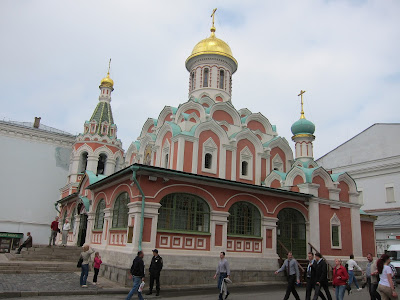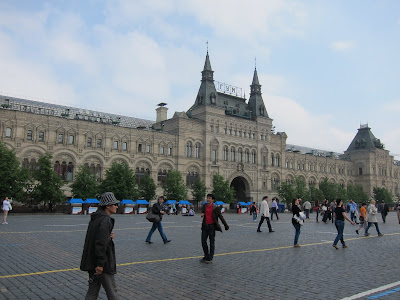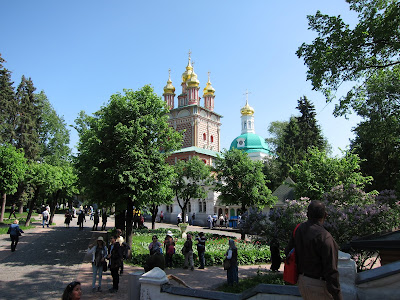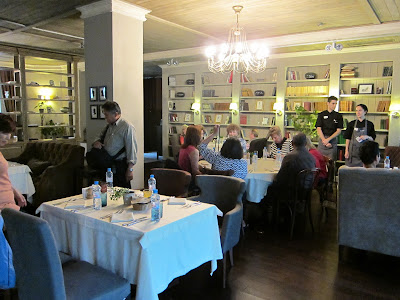The trip was very comfortable. Enroute, we enjoyed the views of the Russian countryside. It was green everywhere. Some of the rural homes looked very basic and did not appear to have electrical supply. I wondered how they pass the cold winters.
We arrived to a wet Moscow at about 6.00pm. It was raining intermittently. Our stay in Moscow was to be quite short - only 3 nights. After we checked into our hotel, it was already dark and there was nothing much we could do. We had just the 2 next full days to explore the city.
The Moskva River flows through the city.
This is Luzhkov bridge. It is a pedestrian bridge across a canal flowing into the Moskva River.
On the bridge and along the banks of the canal are metal trees. Lovers and newly weds come to the bridge to secure love locks on to the trees. They then throw the keys into the canal to signify locking their lives together eternally.
We went up Sparrow Hills. This is one of the highest point in the city. There was a viewing platform in Sparrow Hill, where on a clear day one could get a good panoramic view of Moscow. Unfortunately, when we were up there, the weather was rather foggy.
The most visible building was the Luzhniki Stadium. This was the main stadium of the 1980 Summer Olympics.
Next to the viewing platform was this beautiful green Trinity Church.
The Red Square is Moscow's most famous landmark. We were there twice. First in the morning after Sparrow Hills. In the evening that same day, we went back there again.
There are several prominent buildings around the Red Square. This is the Resurrection Gate and Iberian Chapel. It is also the entrance into the Red Square.
Next to the Resurrection Gate is the State Historical Museum. It is a beautiful and imposing building both in and outside the Red Square.
And the Kazan Cathedral.
This is the Lenin Mausoleum. This is where the embalmed body of Vladimir Lenin lies. Lenin was the supreme leader of the Bolshevik communist revolution that overthrew the Tsar in 1917. He died in 1924.
Along the whole eastern side of the Red Square is Russia's most famous shopping centre. It is GUM, the State Department Store. The shopping mall is huge and very modern inside. Here you can find every brand of western luxury.
The Kremlin Wall is on the western side of the Red Square. At the far end is one of the Kremlin towers with a red star on top.
These are pictures of the Red Square at night, taken during our second visit. The sights of the square was a lot more spectacular at night.
Perhaps the most famous and most photographed building in the Red Square is the St Basil's Cathedral. During our day visit, the access from the Red Square to the cathedral was closed for some reason. We decided to walk around the perimeter of the square to the "back" side of the cathedral. It was a long walk. The sight at the back was somewhat disappointing. It was as pretty as we envisaged.
Fortunately the access was re-opened during our second visit. St Basil's Cathedral was an amazing sight at night.
We walked out of the Red Square heading to the Kremlin. Outside was a very big place - even bigger than the Red Square itself. I do not know if this place has a name.
We walked along the Kremlin wall.
Outside the Red Square and the Kremlin were several monuments. This was the statute of Field Marshal Georgy Zhukov. He was the hero of the Soviet Union during the Second World War. He not only repelled Hilter's invading troops from Russia but also led his troops to capture half of Germany.
This was the tomb of the unknown soldier with an eternal flame.
I am not sure what this monument was.
It was quite a long walk to the the entrance of the Kremlin.
With our tickets, we walked up to the entrance building, passed security...
Walked across a bridge, and entered into the administrative centre of the Russian government.
The Kremlin was an old Russian fortress that had its history from the 2nd century B.C. It is a sprawling 68 acres totally enclosed by the Kremlin Wall. It had been the seat of the Russian government and residence of the Russian Tsars for hundreds of years until Peter the Great built his imperial capital in St Petersburg in 1703. When the Communists came to power, they moved the nation's capital back to Moscow and the Kremlin regained its importance.
Within the Kremlin walls are palaces, cathedrals and a large museum. It is also the official residence of the President of Russia. These buildings were off limits to visitors. Visitors who unknowingly stray towards the buildings were unceremoniously shooed away by security personnels. Perhaps this is where they do their government stuffs and don't want to be disturbed by pesky tourists. Perhaps this is where Mr Putin lives.
This roll of small canons led the big one.
The Tsar Cannon is a giant weighing 40 tons. The cannon balls are 89 cm (35 inches) in diameter. It was built it 1586 but was never used in a war. Experts say the the barrel is too short for its size to be effective. Big but useless. It is now an popular attraction in the Kremlin.
Another useless giant was this Tsar Bell. It is 6.1 metres (20 feet) high and 6.6 metre (22 feet) in diameter. It weighs a staggering 202 tons. It was made in 1735, but before it was completed, it was damaged in a fire. It cracked and a slab weighing 11.5 tons broke off. The bell had never rung. The bell and the broken slab is another attraction in the Kremlin.
The Kremlin is also home to several beautiful cathedrals. We were not allowed to take any picture inside the cathedrals.
This was the Armoury Chamber. It is now the Kremlin museum. In it, is a large collection of the Tsars' belongings - luxurious and elaborate clothing's, crowns & head wears, jewelries, armours & arms, paintings, even royal horse carriages and a lot more. Again, we were not allowed photography.
This was the view from the Kremlin embankment to the Moskva River. Note the Kremlin wall.
Next day, we visited Zagorsk - a city about 70km from Moscow. En-route, we stopped by a small country house. The owner came out to greet us. His home is a really charming place. He must had taken great efforts to make it so. And he obviously was very proud of it.
The actual and original name of the city is Sergiyev Posad. Zagorsk was the name given by the Communists and it is still popularly used. It reverted to its original name after the fall of the communists. Sergiyev Posad is where Russia's biggest and most important monastery is located.
The Holy Trinity - St Sergius Lavra is the spiritual centre, equivalent to the Vatican, of the Russian Orthodox Church. The monastery was founded in 1345. Today it is a popular place of pilgrimage for Russian Orthodox Christians.
The monastery is surrounded by a high wall. At the time of our visit, the wall together with a number of cathedrals inside were undergoing extensive restoration.
Inside the monastery was like a big garden. There were a lot of greeneries. The atmosphere was sombre, befitting the religiosity of the place.
These were a few of the many cathedrals in the monastery.
The interior of the cathedrals were amazing. The artworks were so very delicate and intricate.
Many pilgrims to the Holy Trinity - St Sergius Lavra monastery come to drink holy water from this fountain. The water comes from a nearby spring and is cold and refreshing. Some believe the holy water is kind of elixir of life - makes you younger.
Outside the monastery was a kind of flea market. Locals display all kinds of bric-a-bracs to sell to tourists and pilgrims. Popular are the matryoshka dolls.
On the day we were there, there was an International Festival of Russian Matryoshka Dolls. Tents were erected where people made and sold the matryoshka dolls.
There was a large stage where cultural dances were performed.
These enthusiastic kids were waiting for their turn to perform. One of the boys asked me where I came from and asked for my Facebook name.
Moscow is famous for its underground metro stations. Some of the stations go deep into the ground. The exact depth of the underground metro system is apparently a state secret.
A lot of the stations are very elaborately and beautifully furnished and decorated.
Food wise, Russia to us was a let-down. St Petersburg was not a great culinary location. Moscow was no better. With one or two exceptions, we did not come across many good authentic Russian cuisines. There were only two meals in Moscow that were worthwhile mentioning here. One of them (like St Petersburg's saving grace) was Chinese. I travelled thousands of kilometres to Russia, only to write about Chinese restaurants. Sad.
We were in this Chinese restaurant on the evening we arrived in Moscow. After checking into our hotel, we walked nearly half an hour in intermittent rain to locate this place. We were crazy.
But it was worth the effort. The food were surprisingly quite good. They were not very authentic (we were after all in Russia). But the taste was credible. Like this Szechuan mapo tofu. It was quite delicious. The spiciness was great for the six chilli-starved Malaysians.
This kung po (宫保鸡) chicken was totally unauthentic. It was too mushy. They used peanuts in place of cashew nuts. But heck, the taste was good. We enjoyed it.
I have a hard time trying to remember what this was. Even my wife isn't sure. I think it was pork, cut in strips.
This was Chinese mushrooms braised with bamboo shoots. This was perhaps the most authentic of the dishes we had here. The flavour was not bad at all.
The meat dumpling - kao ji (餃子) was not bad as well. They were very nicely fried. I remember the dumpling skin was good.
This was a steamed fish. It was a nice fillet steamed with light soy sauce. Our only complaint was that the price was hefty.
On our last evening in Russia, we had a kind of good-bye dinner. The restaurant we went to was a very contemporary place known as Terrine.
It had a comfortable and stylish ambiance. The waiters and waitresses were very friendly.
We all ate the same thing. There was no menu selection. We started with a small nice salad.
Followed by a kind of potato cutlet.
The bread they served was freshly baked. They were very nice...
.. with a herbal butter.
This was a delicious consommé, laced with fresh herbs.
The entree was a grilled fish. It was done in a paper wrap. The fish was fresh and the flavour was nice.
Dessert was this lemon cake.
After this meal, we were ready to bid Russia farewell. The next day our Russian visa would expire. And the Russians were very particular about their visitors leaving on time. We were almost at the end of our European tour. But we had one more destination before we finally head for home.

































































































No comments:
Post a Comment